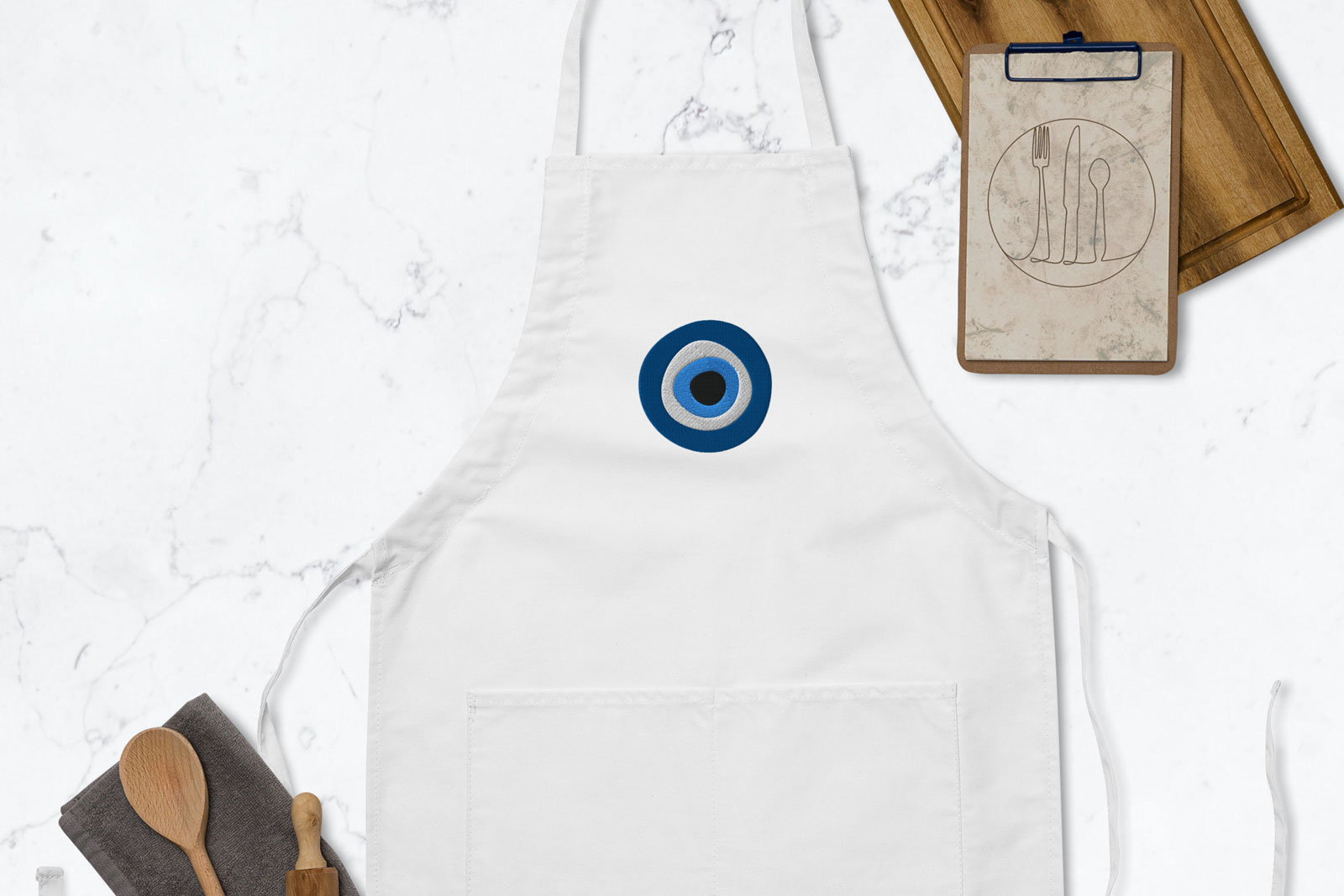Hey there, kitchen maestros and culinary creatives! Let’s talk about one of your most trusted kitchen companions: the embroidered apron. It’s more than just a shield against splatters and spills; it’s a canvas for your culinary adventures, a testament to your passion for food, and often, a personalized work of art. But how do you care for an embroidered apron to ensure it remains a cherished piece in your culinary arsenal for years to come?
Fear not, fellow foodies! This ultimate guide will equip you with all the knowledge and know-how you need to keep your embroidered apron looking as fresh and fabulous as the day you first donned it. We’ll delve into the intricacies of different materials and embroidery types, share expert tips for washing and drying, and even reveal some secret tricks for tackling those pesky stains. So, tie on your apron, grab your favorite spatula, and let’s dive into the art of apron care!
Understanding Your Embroidered Apron: Materials and Embroidery Types
Before we embark on our apron-saving mission, let’s get acquainted with the materials and embroidery types that make your apron unique. Knowing the specifics of your apron will help you tailor your care routine for optimal results.
Apron Fabrics
Cotton
The most common apron fabric, cotton is known for its breathability, absorbency, and easy care. However, it can be prone to wrinkles and fading over time.
Linen
Linen is a natural fiber that’s strong, durable, and gets softer with each wash. It’s also known for its moisture-wicking properties, making it a great choice for hot kitchens. However, linen wrinkles easily and requires careful ironing.
Blends
Many aprons are made from blends of cotton and polyester, linen and cotton, or other combinations. These blends offer the best of both worlds, combining the softness and breathability of natural fibers with the wrinkle resistance and durability of synthetic fibers.
Embroidery Types
Hand Embroidery
This intricate and often delicate form of embroidery requires gentle care to preserve its beauty. Hand-embroidered aprons should be hand-washed or machine-washed on a delicate cycle with cold water.
Machine Embroidery
Machine-embroidered aprons are generally more durable than hand-embroidered ones and can often be machine-washed on a gentle cycle. However, it’s still important to check the care label for specific instructions.
Embroidery Threads
Cotton Thread
Cotton embroidery thread is the most common type and is relatively easy to care for. It can be washed and dried with most fabrics.
Silk Thread
Silk thread is more delicate than cotton and requires special care. It’s best to hand-wash aprons with silk embroidery or have them professionally cleaned.
Metallic Thread
Metallic thread can add a touch of sparkle to your apron, but it’s important to avoid harsh chemicals or high heat, which can tarnish the thread.
Before You Start: Pre-Washing Your Embroidered Apron
Before you unleash your culinary creativity in your new embroidered apron, it’s crucial to give it a pre-wash. This step helps remove any sizing, chemicals, or residues from the manufacturing process that could irritate your skin or damage the embroidery.
To pre-wash your apron, follow these simple steps:
- Fill a sink or basin with cool water.
- Add a small amount of mild detergent and gently swish the apron in the water.
- Rinse the apron thoroughly with cool water.
- Gently squeeze out excess water (don’t wring!).
- Lay the apron flat to dry or hang it to air dry.Pre-washing your apron will not only ensure its cleanliness but also help it maintain its shape and color over time.
Washing Your Embroidered Apron: Gentle Cleaning is Key
The key to caring for an embroidered apron is to treat it gently. Harsh detergents, hot water, and aggressive washing can damage the delicate embroidery threads and shorten the lifespan of your apron.
Here are some tips on how to wash your embroidered apron:
Hand Washing
If your apron is made from a delicate fabric or has intricate embroidery, hand washing is the safest option. Fill a sink or basin with cool water and add a small amount of mild detergent. Gently swish the apron in the water, paying extra attention to any stained areas. Rinse thoroughly with cool water and gently squeeze out excess water. Do not wring, as this can distort the fabric and damage the embroidery.
Machine Washing
Many embroidered aprons can be safely machine-washed. However, it’s crucial to choose the right settings. Always use a gentle or delicate cycle with cold water. Avoid using bleach or fabric softener, as these can damage the fibers and fade the colors. If possible, turn the apron inside out to protect the embroidery during the wash.
Tips for Delicate Embroidered Aprons
For aprons with delicate fabrics or intricate embroidery, place them in a mesh laundry bag before washing to provide extra protection. You can also add a cup of white vinegar to the rinse cycle to help preserve colors and remove any detergent residue.
Drying Your Embroidered Apron: Air is the Way to Go
When it comes to drying your embroidered apron, air drying is always the best option. It’s gentle on the fabric and embroidery and helps prevent shrinkage and fading.
Here’s how to air dry your apron:
- After washing, gently squeeze out excess water (don’t wring!).
- Lay the apron flat on a clean, dry surface or hang it to dry in a well-ventilated area.
- Avoid drying your apron in direct sunlight, as this can fade the colors.
If you’re short on time or space, you can tumble dry your apron on low heat, but be sure to remove it promptly to prevent wrinkles.
Ironing and Removing Wrinkles from Your Embroidered Apron
To keep your embroidered apron looking its best, ironing might be necessary, especially for fabrics like linen. However, it’s important to iron with care to avoid damaging the embroidery.
Ironing Embroidered Aprons
Set your iron to a low or medium heat setting (check the care label for specific instructions). Place a pressing cloth or a thin towel over the embroidery to protect it from direct heat. Iron the apron on the reverse side whenever possible.
Alternative Methods for Removing Wrinkles
If you’re hesitant to iron your embroidered apron, you can try alternative methods for removing wrinkles. Hanging the apron in a humid bathroom or using a garment steamer can help smooth out wrinkles without the risk of scorching the fabric.
Stain Removal: Tackling Common Kitchen Spills on Your Embroidered Apron
Let’s face it, aprons are bound to get stained in the kitchen. But don’t let a little spill ruin your culinary masterpiece! Here are some tips for removing stains from your embroidered apron:
Act Fast
The sooner you address a stain, the easier it will be to remove. Blot the stain with a clean cloth or paper towel to absorb as much of the spill as possible.
Pre-Treating
For stubborn stains, pre-treat the area with a stain remover before washing. You can also try using a paste made from baking soda and water to gently lift the stain.
Safe Stain Removers
Choose stain removers that are safe for delicate fabrics and embroidery threads. Avoid using bleach or harsh chemicals, as these can damage the fabric and cause discoloration.
Test in an Inconspicuous Area
Before applying any stain remover to your apron, test it on a hidden area to ensure it doesn’t damage the fabric or embroidery.
Storage: Protecting Your Embroidered Apron When Not in Use
Proper storage is essential for preserving the beauty and longevity of your embroidered apron.
Here’s how to store it safely:
Choose a Cool, Dry, and Dark Place
Store your apron in a cool, dry place away from direct sunlight, which can fade the colors. A closet or drawer is ideal.
Prevent Wrinkles and Creases
Hang your apron on a padded hanger or fold it carefully to prevent wrinkles and creases. If you must fold it, place a layer of acid-free tissue paper between the folds to protect the embroidery.
Use Garment Bags
For delicate or valuable embroidered aprons, consider storing them in garment bags to protect them from dust and damage.
Repairing Your Embroidered Apron:
Mending Minor Damage
Accidents happen, and even the most well-cared-for aprons can experience minor damage. Here are some tips for repairing your embroidered apron:
Loose Threads
If you notice any loose threads, carefully trim them with a pair of scissors. Avoid pulling on the thread, as this could unravel the embroidery.
Small Holes
Small holes or tears in the fabric can be mended with a needle and thread. Use a thread that matches the color of the fabric as closely as possible.
Professional Repair
For more extensive damage, such as large holes or torn embroidery, it’s best to seek professional repair from a tailor or embroidery specialist.
Conclusion: Cherishing Your Embroidered Apron for a Lifetime of Culinary Creations
Your embroidered apron is more than just a kitchen accessory; it’s a badge of honor for your culinary adventures. It’s a symbol of your passion for food, a testament to your creativity, and a reminder of the countless delicious meals you’ve prepared while wearing it. By following the tips and tricks in this ultimate guide on how to care for an embroidered apron, you can ensure that your apron remains a cherished part of your kitchen for years to come.
Remember, a little extra care goes a long way in preserving the beauty and functionality of your embroidered apron. Treat it with respect, and it will continue to serve you well, inspiring you to create culinary masterpieces and making every cooking experience a joyful one. So, whether you’re a seasoned chef or a home cook just starting out, give your embroidered apron the love it deserves, and it will reward you with a lifetime of delicious memories.



